
In a world increasingly defined by innovation and intellectual property, staying ahead of the curve has never been more critical. As technology evolves at an unprecedented pace, so does the need for IP professionals to adapt and optimize their portfolio management strategies.
Fortunately, we are on the cusp of a transformative era, where Artificial Intelligence (AI) is poised to revolutionize the way we approach, protect, and extract value from intellectual assets. In this blog, we embark on a journey to uncover 10 groundbreaking AI-powered solutions that promise to reshape the landscape of IP portfolio management.
From the creation and analysis of patents to ethical considerations and collaboration enhancement, these innovations are poised to empower patent professionals like never before. Join us as we delve into the future of IP management, where AI is at the forefront of innovation and efficiency.
1. Intellectual Property Creation: How AI is Transforming the Process
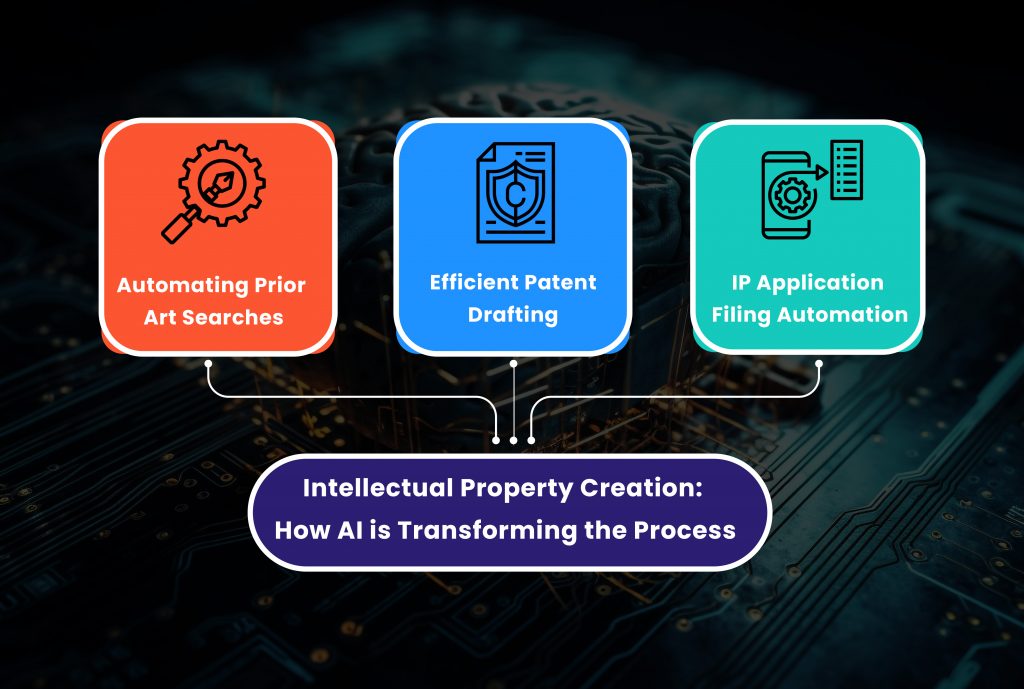
In the ever-evolving landscape of intellectual property (IP) management, the process of creating and safeguarding these invaluable assets is undergoing a remarkable transformation, thanks to the integration of Artificial Intelligence (AI).
This revolution in IP creation is not just streamlining the way organizations protect their intellectual property but also enhancing precision and efficiency across the board.
Automating Prior Art Searches
One of the key areas where AI is making a profound impact is in automating prior art searches. Traditionally, these searches involved exhaustive manual research to determine if an invention or idea was indeed novel and eligible for patent protection.
However, AI-driven systems now expedite this process by scouring vast databases, scientific literature, and patents to identify similar prior art. This not only saves considerable time but also ensures a more comprehensive search, reducing the risk of overlooking relevant references.
Efficient Patent Drafting
Once the prior art search is complete, AI continues to prove its worth by assisting in patent drafting. AI-powered algorithms can analyze existing patents and generate preliminary patent drafts based on the provided information.
This not only accelerates the patent application process but also helps in maintaining consistency and adherence to legal standards. Patent professionals can then focus their expertise on refining the drafted patents, ultimately improving the quality of applications.
IP Application Filing Automation
AI not only simplifies the creation of patents but also automates the application filing process. This reduces the risk of errors and ensures that applications are submitted promptly, taking full advantage of filing deadlines.
As a result, organizations can secure their intellectual property rights more efficiently and with greater precision.
2. Strategic Insights via Predictive Analytics
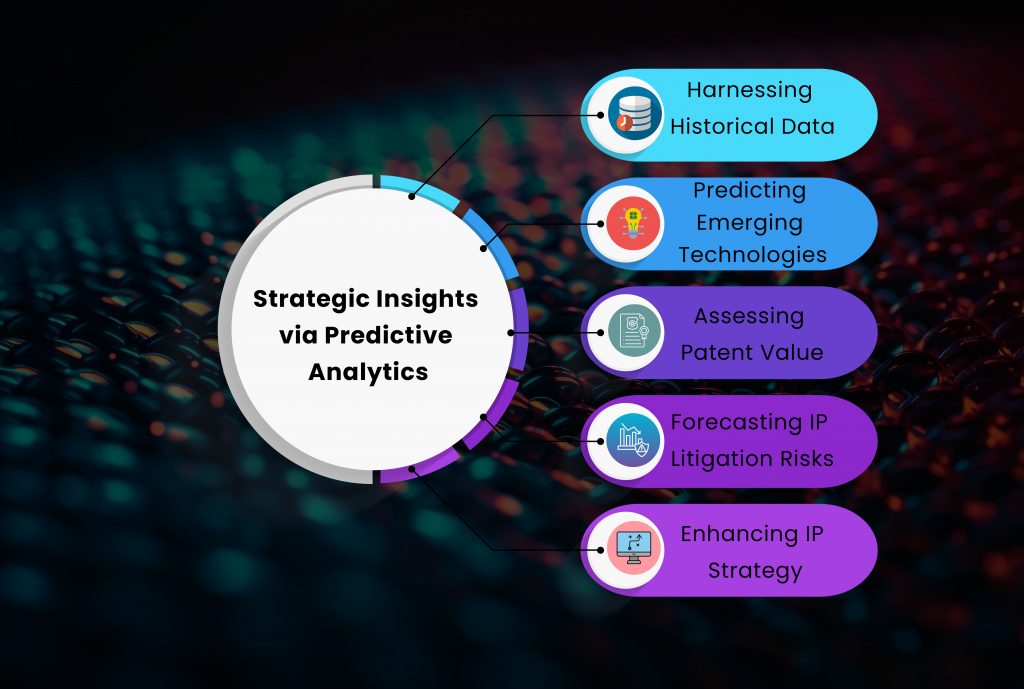
In the rapidly changing landscape of intellectual property (IP) management, the ability to make informed decisions is paramount. This is where Artificial Intelligence (AI) steps in, offering predictive patent analytics that can revolutionize how organizations strategize, protect, and leverage their patents.
Harnessing Historical Data
One of the foundational elements of predictive patent analytics is its ability to harness historical data. AI algorithms can sift through vast troves of historical patents, identifying patterns and trends that may not be immediately apparent to human analysts.
By analyzing this data, AI can provide insights into the evolution of specific technologies, market dynamics, and even the strategies of competitors.
Predicting Emerging Technologies
AI’s predictive capabilities extend to anticipating emerging technologies. By analyzing current IP trends and historical data, AI can identify areas of innovation poised for growth.
This allows organizations to proactively allocate resources for research and development in promising technology domains, gaining a competitive edge by being ahead of the curve.
Assessing Patent Value
Determining the value of patents is a crucial aspect of IP strategy. AI-driven tools can assess the value of patents based on a variety of factors, including their citation count, litigation history, and industry relevance.
This evaluation goes beyond traditional methods, providing a more nuanced understanding of a patent’s worth. It helps organizations make informed decisions regarding patent acquisition, licensing, or divestiture.
Forecasting IP Litigation Risks
Another vital dimension of predictive IP analytics is its ability to forecast IP litigation risks. By examining historical IP litigation data, AI can identify patterns and factors that contribute to legal disputes.
This insight empowers organizations to take preventive measures, such as adjusting their IP strategies or exploring alternative dispute resolution methods, reducing the potential financial and reputational impact of litigation.
Enhancing IP Strategy
Incorporating AI-driven predictive analytics into IP strategy enhances decision-making. Organizations can align their IP portfolios with market trends, optimize resource allocation, and mitigate risks more effectively.
This strategic advantage allows for greater agility in responding to changes in the IP landscape, ensuring that IP assets remain valuable and competitive.
3. Revolutionizing Patent Analysis: The Power of AI
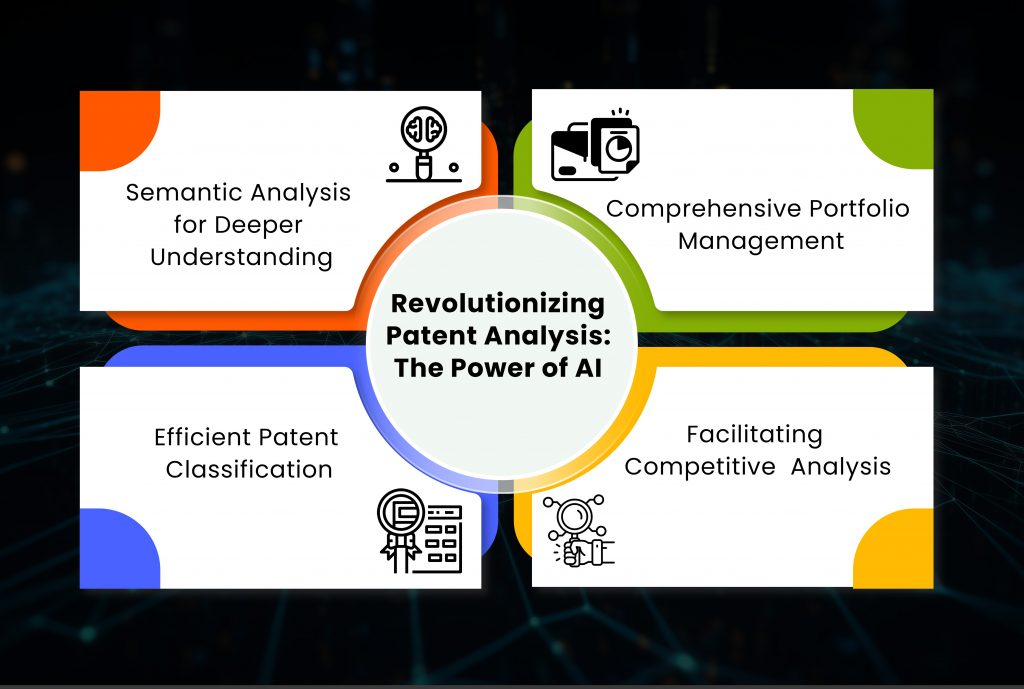
In the world of intellectual property (IP), patents stand as a cornerstone of innovation, protection, and competition. Analyzing patents effectively is a critical aspect of IP management, and Artificial Intelligence (AI) has emerged as a transformative force in this endeavor.
Semantic Analysis for Deeper Understanding
Beyond the basics, AI excels in semantic analysis, enabling a deeper understanding of patent documents. It can decipher complex technical language, identifying key concepts, relationships, and innovations within patents.
This capability makes it easier for IP professionals to grasp the essence of a patent and its claims, facilitating more precise assessments of its relevance and potential applications.
Efficient Patent Classification
AI’s prowess extends to patent classification, a crucial step in organizing and categorizing patents. AI algorithms can automatically classify patents into specific technology domains, simplifying portfolio management and competitive analysis.
This categorization streamlines the process of identifying relevant patents and assessing their impact on a company’s IP strategy.
Comprehensive Portfolio Management
AI is not limited to simplifying individual patent analyses; it also aids in comprehensive portfolio management. IP professionals can leverage AI to assess the strength and potential value of their IP portfolios.
This enables them to make informed decisions about which patents to protect, license, or divest, optimizing their IP strategy for maximum impact.
Facilitating Competitive Analysis
Understanding the competitive landscape is another crucial aspect of patent analysis. AI-powered tools can help organizations monitor the patent activity of competitors, identify emerging trends, and even predict their future strategies.
This strategic advantage enables companies to stay ahead of the competition and adapt their IP strategies accordingly.
4. Intellectual Property Due Diligence Reimagined: The AI Advantage

Intellectual property (IP) due diligence is a critical process, often undertaken during mergers and acquisitions, investment decisions, or partnerships. It involves a comprehensive examination of patent data, trademarks, copyrights, and prior art to assess the value, risks, and opportunities associated with an IP portfolio.
In recent years, Artificial Intelligence (AI) has emerged as a game-changer in this arena, revolutionizing the way IP due diligence is conducted.
Accurate Analysis Across Multiple Domains
One of AI’s most compelling contributions to IP due diligence is its ability to conduct accurate analysis across various IP domains. Whether it’s patents, trademarks, or copyrights, AI can rapidly process and evaluate vast datasets, identifying potential risks and opportunities.
This comprehensive analysis ensures that no stone is left unturned when assessing the IP landscape.
Risk Identification and Mitigation
AI excels at risk identification and mitigation in IP due diligence. By analyzing historical IP data and market trends, AI-powered systems can pinpoint potential risks associated with an IP portfolio.
This includes identifying patents with a history of litigation, trademarks with potential conflicts, or copyrights with licensing disputes. Armed with this information, organizations can take proactive measures to mitigate these risks, ensuring a smoother transition in M&A deals or investment decisions.
Valuation Trends and Licensing Opportunities
AI-driven tools also excel at identifying valuation trends and licensing opportunities within an IP portfolio. By assessing factors such as citation counts, licensing history, and industry relevance, AI can provide a more accurate valuation of IP assets.
This insight enables organizations to negotiate favorable terms in licensing agreements and make informed decisions regarding IP investments.
Anticipating Market Dynamics Changes
Another significant advantage of AI in IP due diligence is its ability to anticipate changes in market dynamics. By monitoring industry trends, emerging technologies, and competitor activities, AI-powered systems can provide insights into how the IP landscape may evolve.
This strategic foresight enables organizations to adapt their IP strategies proactively, ensuring they stay ahead in a rapidly changing environment.
5. AI Automating Patent Portfolio Management
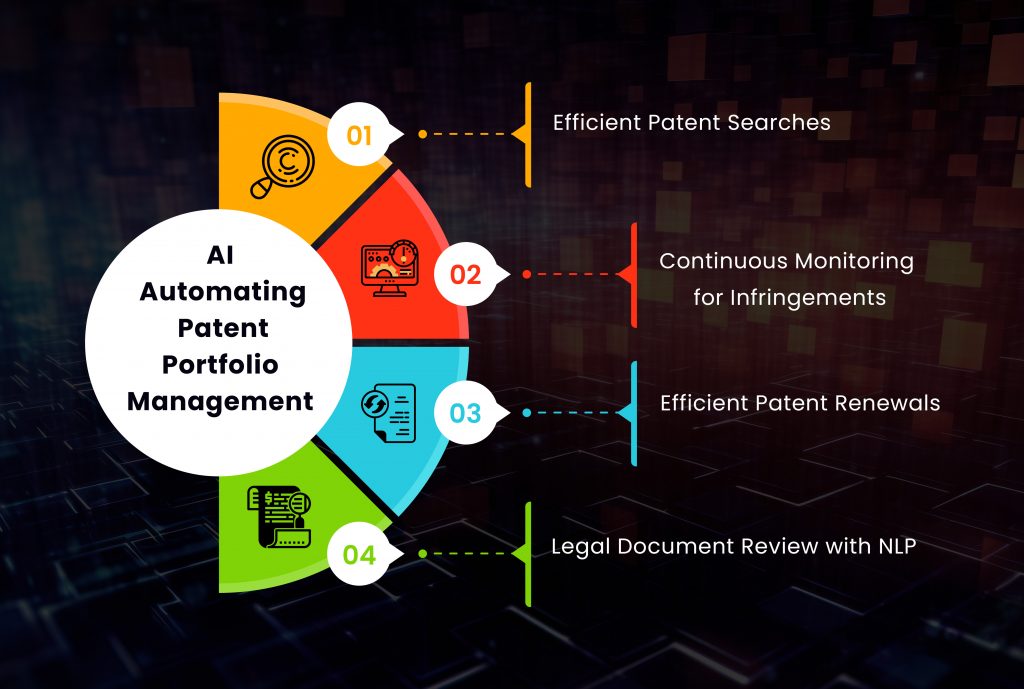
In today’s rapidly evolving business landscape, intellectual property (IP) assets, especially patents, hold immense value. Effectively managing a patent portfolio can be a daunting task, but with the advent of Artificial Intelligence (AI), it has become not only manageable but remarkably efficient.
Efficient Patent Searches
One of the fundamental steps in patent portfolio management is conducting patent searches. AI algorithms excel in this task by swiftly scanning through vast databases, scientific literature, and patent records.
They not only expedite the search process but also enhance its comprehensiveness, ensuring that no potentially relevant patents are overlooked. This efficiency not only saves time but also contributes to a more comprehensive patent portfolio.
Continuous Monitoring for Infringements
AI extends its capabilities to continuous monitoring for patent infringements. It can scan a broad spectrum of sources, including online platforms, marketplaces, and competitor activities, to identify potential infringements promptly.
This proactive approach allows organizations to protect their patent rights more effectively and take necessary legal actions when infringements occur.
Efficient Patent Renewals
Managing patent renewals is a crucial but often complex task. AI simplifies this process by automating patent renewal tracking.
It can alert IP professionals to upcoming renewal deadlines, ensuring that patents are maintained without lapses. This not only saves administrative effort but also minimizes the risk of inadvertent patent expiration.
Legal Document Review with NLP
AI, particularly Natural Language Processing (NLP), enhances legal document review in patent portfolio management. It can analyze complex legal documents, contracts, and agreements, extracting key insights and identifying potential risks.
This capability enables organizations to streamline legal document review processes and make informed decisions more efficiently.
6. Intellectual Property Enforcement
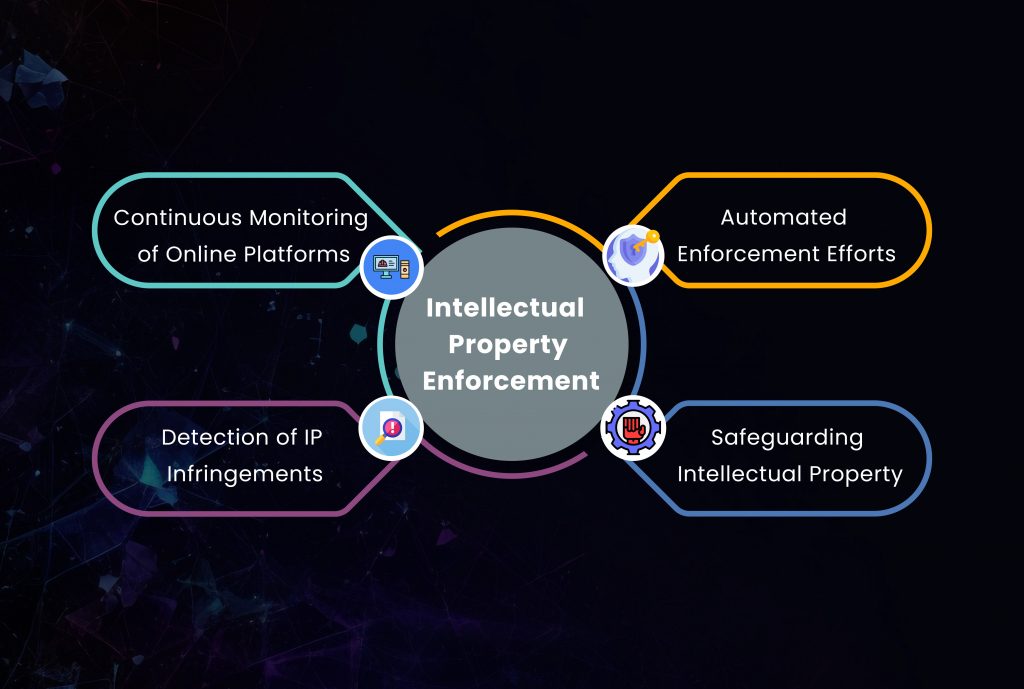
In today’s digital age, the protection and enforcement of intellectual property (IP) have taken on new dimensions. Intellectual property enforcement, often a challenging and resource-intensive task, has been significantly enhanced by the integration of Artificial Intelligence (AI).
Continuous Monitoring of Online Platforms
The internet has opened up vast opportunities for businesses and creators, but it has also brought about unprecedented challenges in terms of IP infringement. AI plays a pivotal role in addressing this issue by continuously monitoring online platforms.
It scans websites, social media platforms, e-commerce sites, and digital marketplaces, seeking out instances of IP violations. This proactive approach ensures that IP rights are protected across the ever-expanding digital landscape.
Detection of IP Infringements
AI’s ability to detect IP infringements goes beyond traditional methods. It can analyze both visual and textual content, identifying unauthorized use of trademarks, copyrighted material, and patents.
Whether it’s detecting counterfeit products, copyright violations in images and videos, or trademark infringements in product listings, AI can swiftly pinpoint potential violations, enabling rapid response.
Automated Enforcement Efforts
One of the most significant advantages of AI in IP enforcement is its capacity to automate enforcement efforts. For example, if AI detects counterfeit products being sold online, it can initiate automated takedown requests, sending notices to platforms and sellers to remove the infringing listings.
This automation not only saves time and resources but also ensures a rapid response to IP infringements.
Safeguarding Intellectual Property
Ultimately, AI is a guardian of intellectual property, safeguarding it against threats in the digital realm. It ensures that IP rights are respected, preventing unauthorized use and commercial exploitation.
This protection extends to all forms of intellectual property, from patents and trademarks to copyrights and trade secrets.
7. Seamless IP Continuity: How AI Revolutionizes Renewals and Maintenance
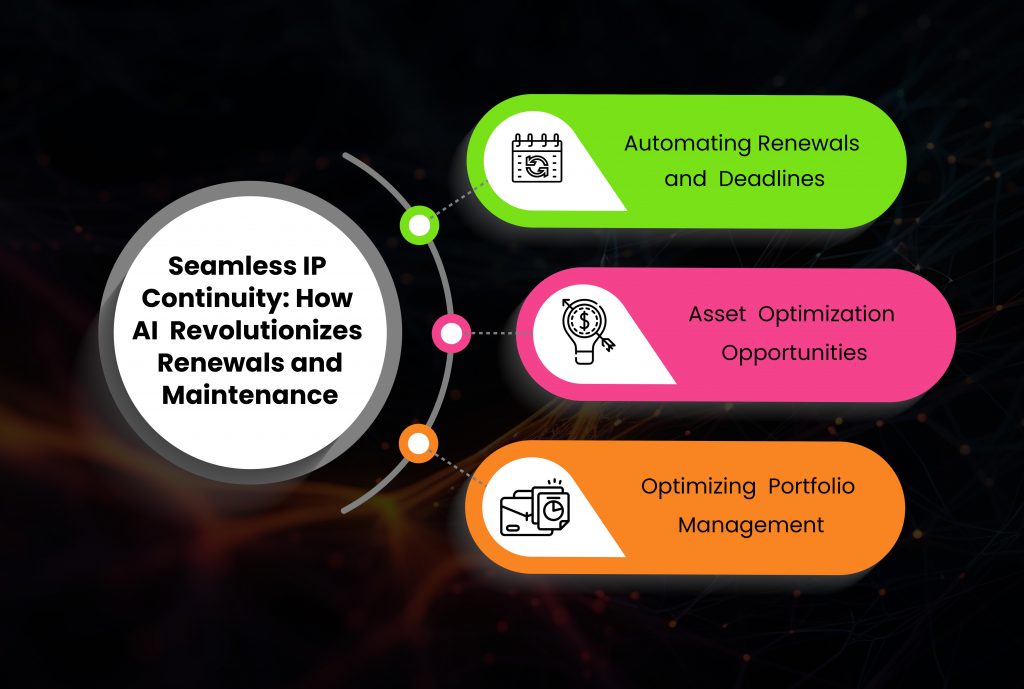
In the intricate world of intellectual property (IP), the management of renewals and maintenance is a mission-critical task. IP assets, including patents, trademarks, and copyrights, require meticulous attention to ensure their continuous protection and value.
The advent of Artificial Intelligence (AI) has ushered in a new era, making IP renewals and maintenance more efficient and effective than ever before.
Automating Renewals and Deadlines
Managing IP renewals involves tracking deadlines for various IP assets, which can be a complex and error-prone task when done manually.
AI simplifies this process by automating IP renewals and deadline tracking. AI-driven systems can maintain a comprehensive calendar of renewal dates, sending alerts and reminders to IP professionals well in advance of deadlines. This automation ensures that no IP rights lapse due to oversight, safeguarding the continuity of valuable assets.
Optimizing Portfolio Management
AI doesn’t stop at automating renewals but also optimizes portfolio management. It can analyze the IP portfolio’s composition, assessing the value, strength, and relevance of individual assets.
This analysis helps organizations make informed decisions about which assets to renew, license, or divest. By optimizing the portfolio, organizations can allocate resources more strategically, ensuring that their IP assets remain valuable and aligned with their business goals.
Asset Optimization Opportunities
AI goes a step further by identifying asset optimization opportunities. It can evaluate whether certain IP assets are underutilized or have greater potential for value creation.
For example, AI can identify patents that may have licensing opportunities or copyrights that can be monetized through content distribution. This proactive approach ensures that IP assets not only remain protected but also contribute to revenue generation.
8. Revolutionizing Contract Review and Management with AI
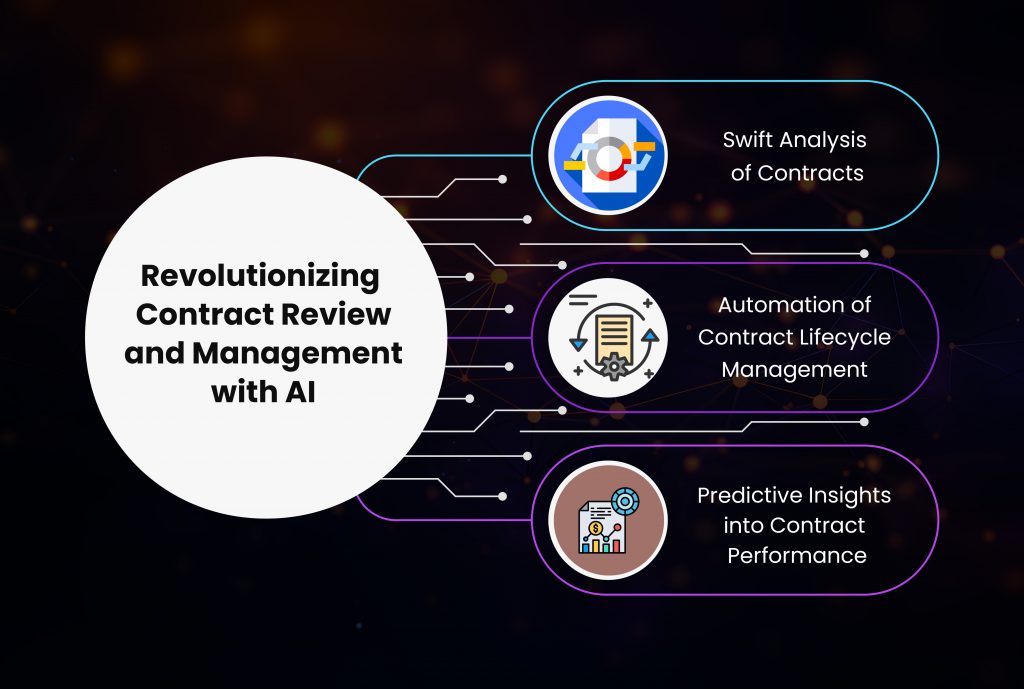
In the fast-paced business world, contracts are the backbone of legal agreements and business relationships. Efficient contract review and management are essential for ensuring compliance, reducing risks, and optimizing operations.
With the advent of Artificial Intelligence (AI), the traditionally time-consuming and labor-intensive tasks associated with contracts are undergoing a radical transformation.
Swift Analysis of Contracts
One of the most significant advantages of AI in contract review and management is its ability to swiftly analyze contracts.
AI-powered systems can process a large volume of contracts in a fraction of the time it would take a human reviewer. They can extract key terms, clauses, and obligations, ensuring that nothing critical is overlooked.
Automation of Contract Lifecycle Management
AI takes contract management to the next level by automating the entire contract lifecycle. From contract creation and negotiation to execution and monitoring, AI can streamline the entire process.
It can automatically generate contracts based on predefined templates, track changes during negotiations, and manage contract renewals and terminations. This automation not only saves time but also ensures that contracts are consistently managed in compliance with legal requirements and organizational policies.
Predictive Insights into Contract Performance
One of the most valuable aspects of AI in contract management is its predictive analytics capabilities. AI can analyze historical contract data to offer insights into contract performance. This includes assessing factors like compliance rates, delivery timelines, and financial obligations.
These insights help organizations make informed decisions about contract renewals, renegotiations, or terminations. Additionally, predictive analytics can identify potential risks or opportunities, enabling organizations to proactively address issues or capitalize on advantages.
9. Enhanced Collaboration and Communication
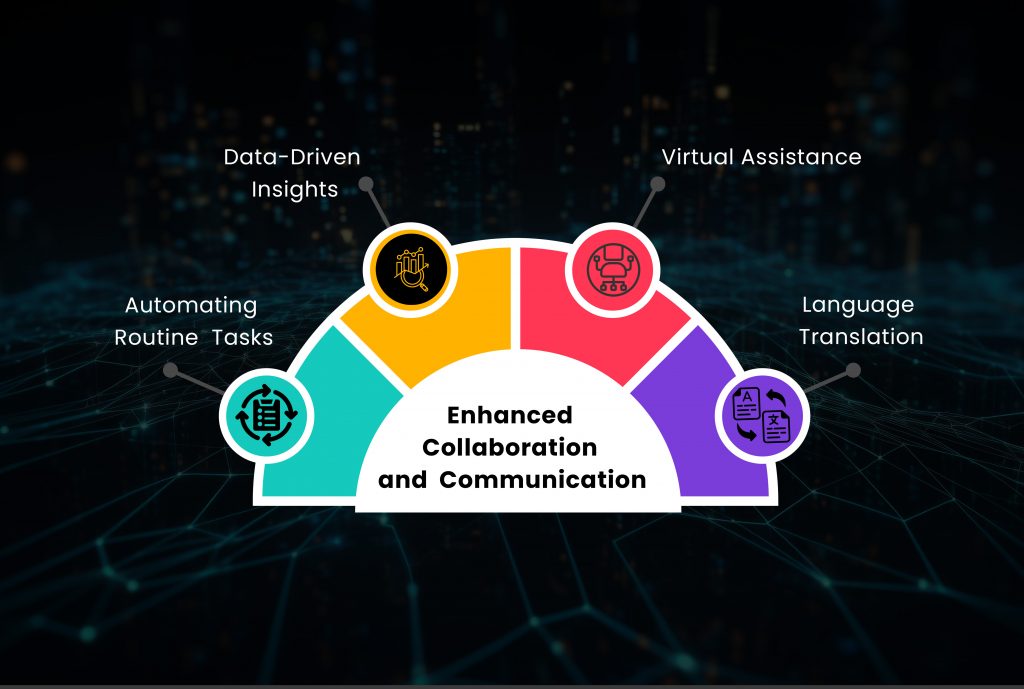
In today’s interconnected and fast-paced business environment, effective collaboration and communication are essential for success.
Whether within teams, across departments, or with global partners, the ability to collaborate seamlessly and communicate clearly is paramount. Enter Artificial Intelligence (AI), a transformative force that is reshaping the landscape of collaboration and communication.
Automating Routine Tasks
AI is a game-changer when it comes to automating routine tasks that can consume valuable time and resources. From scheduling meetings and managing calendars to setting reminders and sending notifications, AI can handle these repetitive functions with ease.
This automation not only reduces administrative burdens but also ensures that routine tasks are completed efficiently.
Data-Driven Insights
AI’s real power lies in its ability to provide data-driven insights. It can analyze vast amounts of data, including communication histories, to offer actionable insights.
For example, AI can identify communication patterns within an organization, such as which teams collaborate most frequently, or which topics generate the most discussion. These insights enable organizations to make informed decisions regarding resource allocation, workflow improvements, and strategic priorities.
Virtual Assistance
AI-powered virtual assistants are increasingly becoming integral to enhancing collaboration and communication. These virtual assistants can handle inquiries, provide information, and even assist in language translation. This multi-faceted support enhances cross-cultural collaboration and ensures that language barriers do not hinder effective communication.
Language Translation
In an increasingly globalized business world, language differences can be a challenge. AI offers solutions by providing real-time language translation services.
This capability enables teams from diverse linguistic backgrounds to collaborate seamlessly, fostering a more inclusive and effective working environment.
10. Ethical & Privacy Considerations
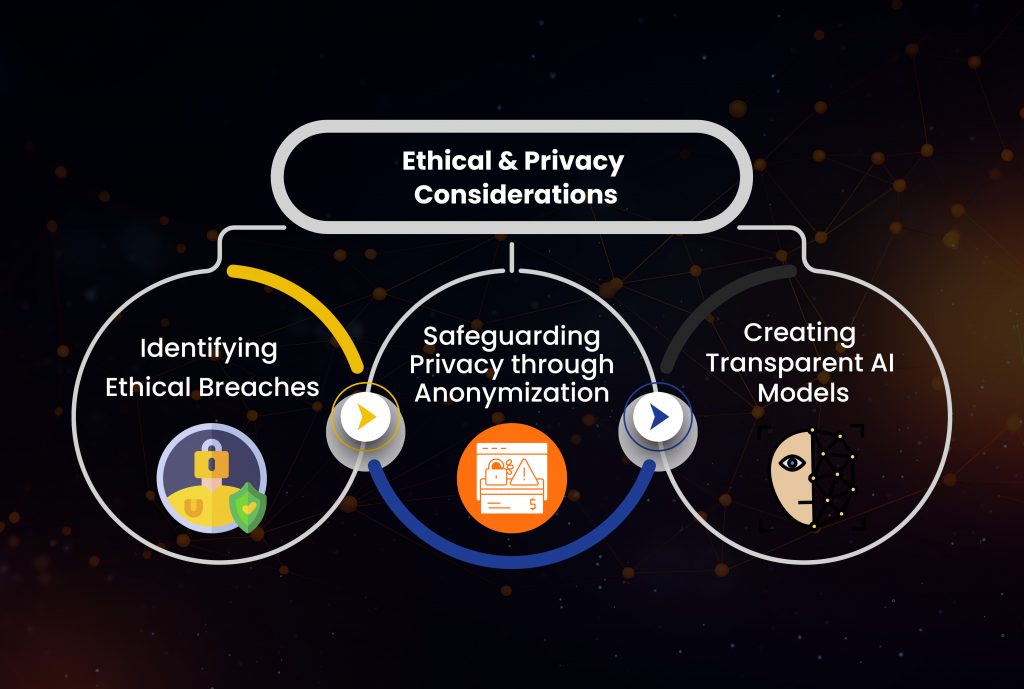
As the adoption of Artificial Intelligence (AI) continues to accelerate across industries, it brings to the forefront not just innovation but also ethical and privacy considerations.
The vast amount of data AI systems process and the potential for automated decision-making raise important questions about how to ensure the responsible and ethical use of AI.
Identifying Ethical Breaches
AI is not just a technology but a tool that can be used for both good and potentially harmful purposes. One of its crucial roles is in identifying ethical breaches or biases within AI algorithms.
AI can scan data and algorithms for biases related to race, gender, or other sensitive attributes and raise alerts when such biases are detected. This proactive approach helps organizations correct these issues, ensuring that AI systems are fair and unbiased.
Safeguarding Privacy through Anonymization
Privacy is a fundamental right, and AI plays a crucial role in safeguarding it. AI systems can anonymize data, removing personally identifiable information to protect individuals’ privacy. This anonymization allows organizations to leverage data for insights while respecting privacy laws and regulations.
Creating Transparent AI Models
Transparency is vital in building trust in AI systems. AI can help achieve this by providing explanations for its decisions and actions.
For example, AI models can generate explanations for why a particular decision was made, helping individuals and organizations understand the reasoning behind AI-driven outcomes. Transparent AI models contribute to accountability and ethical use.
Conclusion
In conclusion, Artificial Intelligence (AI) is revolutionizing every facet of intellectual property (IP) management, from the creation and analysis of patents to strategic insights via predictive analytics.
It is streamlining the due diligence process, automating patent portfolio management, enhancing intellectual property enforcement, ensuring IP continuity through renewals and maintenance, and facilitating improved collaboration and communication. Moreover, AI is also addressing ethical and privacy concerns, making responsible AI adoption a reality.
These advancements in AI-driven solutions are empowering organizations to stay competitive in an ever-evolving global landscape. They are providing tools to optimize IP portfolio management, protect intellectual property rights, and make data-driven decisions that enhance efficiency and effectiveness.
As AI technology continues to evolve and mature, it promises to further revolutionize the way intellectual property is managed, offering organizations a competitive edge in safeguarding, leveraging, and maximizing the value of their intellectual assets.
In this era of technological transformation, embracing AI-driven solutions for IP management is not merely a choice but a strategic imperative. Those who harness the power of AI in this domain will be better equipped to navigate the complex IP landscape, drive innovation, and secure their position as leaders in their respective industries.
As we move forward, the future of intellectual property management is undoubtedly intertwined with the limitless possibilities that AI offers, ensuring that intellectual assets remain not just protected but also a driving force for growth and innovation.

